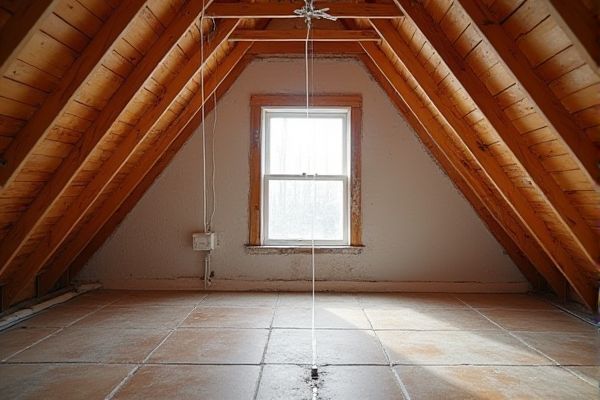
Attic air leak sealant provides a permanent solution by sealing gaps and cracks to prevent heat loss, while weatherstripping offers a flexible, removable barrier primarily for doors and windows. Discover how each option can improve your home's energy efficiency and which one suits Your needs best in the rest of this article.
Table of Comparison
| Feature | Attic Air Leak Sealant | Weatherstripping |
|---|---|---|
| Purpose | Seals gaps and cracks in attic to prevent air leaks | Blocks air infiltration around doors and windows |
| Material | Acrylic, silicone, polyurethane foam | Foam, rubber, vinyl, felt |
| Application Area | Attic floor, rim joists, penetrations | Door frames, window sashes, sliding tracks |
| Installation | Applied using caulking gun or spray foam can | Adhesive-backed strips or V-strip installation |
| Durability | Long-lasting, resistant to moisture and temperature | Moderate; may compress and wear over time |
| Cost | Moderate to high depending on product type | Low to moderate |
| Energy Efficiency Impact | High; reduces attic air leakage significantly | Medium; reduces drafts at openings |
| Maintenance | Minimal; reapplication if cracks reappear | Periodic replacement recommended |
| Best Use | Sealing large gaps, difficult-to-reach attic leaks | Sealing movable joints around doors and windows |
Introduction to Attic Air Leak Solutions
Attic air leak sealants create an airtight barrier by filling cracks, gaps, and holes in your attic, preventing warm air from escaping and improving energy efficiency. Weatherstripping involves applying flexible materials around attic doors or hatches to block drafts and reduce heat loss. Choosing the right solution depends on the specific type and location of leaks in your attic to maximize insulation performance.
Understanding Attic Air Leaks
Attic air leaks commonly occur around gaps, cracks, and openings in the attic floor and ceiling, causing significant energy loss. Sealants are ideal for permanently closing these irregular or hard-to-reach cracks, ensuring long-term airtightness. Weatherstripping works best on movable attic components like access doors, helping you create a temporary but effective barrier against drafts.
What Is Attic Air Leak Sealant?
Attic air leak sealant is a specialized foam or caulking material designed to fill cracks, gaps, and holes in attic spaces, preventing warm or cool air from escaping and improving energy efficiency. Unlike weatherstripping, which is typically applied to movable components like doors and windows to block drafts, air leak sealant provides a more permanent and airtight barrier for stationary surfaces. Properly sealing attic leaks with the right sealant can significantly reduce heating and cooling costs by minimizing unwanted air infiltration.
What Is Attic Weatherstripping?
Attic weatherstripping is a material applied to attic doors, hatches, or access points to create an airtight seal, preventing warm or cool air from escaping. Unlike attic air leak sealants, which fill cracks and gaps to stop air leaks, weatherstripping is typically flexible and removable, designed to maintain easy access while improving energy efficiency. Effective attic weatherstripping reduces HVAC strain by minimizing energy loss and maintaining consistent indoor temperatures.
Key Differences: Sealant vs Weatherstripping
Sealant for attic air leaks is a liquid or foam-based material designed to permanently close gaps and cracks, providing an airtight and durable barrier. Weatherstripping, made from flexible materials like rubber or foam, is applied around movable components such as attic doors to block drafts while allowing for repeated opening and closing. Choosing between sealant and weatherstripping depends on whether you need a permanent seal for fixed leaks or a removable solution for access points in Your attic.
Performance Comparison: Energy Efficiency
Attic air leak sealant provides superior energy efficiency by creating a permanent barrier against drafts and heat loss, effectively reducing your heating and cooling costs over time. Weatherstripping, while easier to install and maintain, primarily addresses small gaps around doors and windows rather than the extensive air leaks common in attics. For optimal energy savings, sealing attic leaks with specialized sealants outperforms weatherstripping by preventing significant heat transfer and improving overall home insulation.
Installation Process: Sealant vs Weatherstripping
Sealant installation in attics involves applying caulk or foam directly to cracks and gaps, creating a permanent, airtight seal ideal for irregular or hard-to-reach areas. Weatherstripping requires measuring, cutting, and fitting flexible strips around movable components like attic doors or access panels, offering a removable and adjustable barrier. Choosing between sealant and weatherstripping depends on the nature of the air leak and desired durability, with sealants providing long-term sealing and weatherstripping allowing for easier maintenance or adjustments.
Cost Analysis: Materials and Labor
Attic air leak sealants typically cost between $0.50 and $3.00 per square foot for materials, with professional labor ranging from $1.00 to $3.00 per square foot, depending on the size and complexity of the job. Weatherstripping materials are generally less expensive, averaging $5 to $30 per linear foot, with labor costs around $50 to $150 per hour for installation. Overall, sealants often present a more cost-effective solution for extensive attic leaks, while weatherstripping is more economical for smaller, easily accessible gaps.
Longevity and Maintenance Considerations
Attic air leak sealants offer long-lasting durability by creating a permanent barrier against air infiltration, often lasting several years without requiring reapplication. Weatherstripping, while easier to install and replace, tends to degrade faster due to exposure to temperature fluctuations and wear, necessitating more frequent maintenance. Choosing between sealants and weatherstripping depends on balancing the desire for minimal upkeep with the need for flexibility in attic access points.
Choosing the Best Attic Air Leak Solution
Choosing the best attic air leak solution depends on the type and location of gaps: attic air leak sealants like spray foam or caulk effectively fill irregular or hard-to-reach cracks, providing long-term airtightness and energy efficiency. Weatherstripping, typically made from rubber, foam, or vinyl, is ideal for movable attic components such as access doors or hatches, offering easy installation and replaceability. Prioritize air leak sealant for structural gaps and weatherstripping for dynamic or frequently accessed areas to optimize insulation and reduce energy costs.
 homyna.com
homyna.com